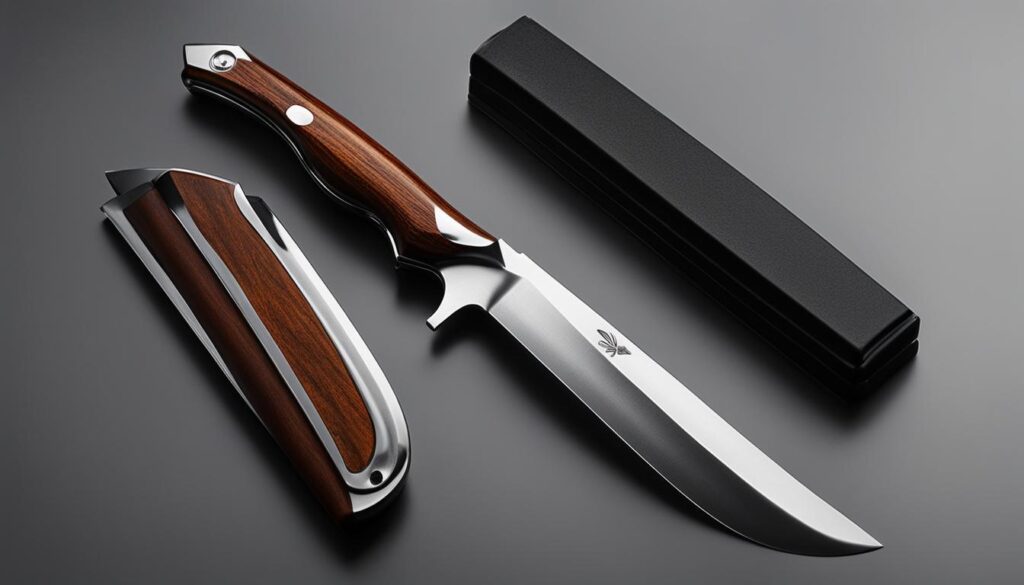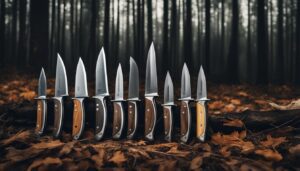When it comes to hunting knives, blade length plays a crucial role in ensuring efficient butchering. As a hunting enthusiast, I have delved into the world of knife selection and discovered the ideal blade length for effortless butchering. Join me on this guide as we explore the significance of blade length, the factors to consider when choosing a hunting knife, top recommendations, different types of outdoor knives, and essential conclusions for selecting and maintaining your hunting knife.
Key Takeaways:
- Blade length is an important factor for effortless butchering with hunting knives.
- An ideal blade length of 3 to 4 inches allows for easy dressing of game.
- Consider the size of the game when selecting a blade length.
- Fixed blade and folding blade options both have their pros and cons.
- A gut hook is not essential but can be convenient for field dressing.
Factors to Consider when Choosing a Hunting Knife
When selecting a hunting knife, there are several factors that you should consider to ensure you find the right tool for your needs. Understanding the key features and options available will help you make an informed decision. Here are some important factors to keep in mind:
Blade Types:
The type of blade on a hunting knife can greatly impact its performance. The two most common blade types are the drop point and clip point.
The drop point blade offers a strong and durable tip that is suitable for a wide range of tasks. Its large belly makes it ideal for skinning and slicing, as well as general-purpose cutting. On the other hand, the clip point blade has a thinner and finer tip, making it excellent for precise and delicate work, such as gutting and caping.
Fixed vs. Folding Blade:
Another important consideration is whether to choose a fixed blade or a folding blade hunting knife.
A fixed blade knife is generally more robust and reliable, as it has no moving parts. It offers a stronger and more secure blade, making it suitable for heavier tasks and providing better control. Fixed blade knives are also easier to clean and maintain. On the other hand, folding blade knives are more compact and portable, making them convenient for everyday carry and situations where space is limited.
Gut Hook:
A gut hook is a specialized feature found on some hunting knives. It is a small, sharpened hook on the spine of the blade, near the tip.
The gut hook is designed to make field dressing easier by allowing you to open the animal’s abdomen without puncturing the internal organs. Some hunters find it extremely useful, while others prefer not to have it, as it can get in the way during general use. Consider your personal preferences and the specific tasks you’ll be performing when deciding whether to choose a hunting knife with a gut hook.
By considering these factors and evaluating your specific needs, you can select a hunting knife that meets your requirements and enhances your hunting experience.
Top Hunting Knives Recommendations
When it comes to choosing the best hunting knife, there are several top options on the market. These knives offer durability, functionality, and excellent performance for hunting enthusiasts. Here are my top recommendations for hunting knives:
Spyderco Bill Moran
This knife features a 3.88-inch drop point blade made of quality VG-10 steel. The simple design of the Spyderco Bill Moran offers excellent grip, making it a reliable choice for various hunting tasks.
Buck Model 110 Hunter
The Buck Model 110 Hunter is a classic and iconic knife, known for its quality and reliability. It has a 3.75-inch blade made of 420HC steel and a lockback mechanism for added safety during use.
Fallkniven H1z
Made in Sweden, the Fallkniven H1z boasts a 4-inch laminated VG-10 steel blade, which offers exceptional strength and durability. The textured Thermorun handle provides a secure grip, even in wet conditions.
Gerber Gator Fixed Blade
If you’re looking for a budget-friendly option, the Gerber Gator Fixed Blade is a great choice. It features a 4.02-inch blade made of 420HC steel and a glass-filled nylon handle, providing a comfortable and reliable grip.
CRKT Onion Skinner
Designed by Ken Onion, the CRKT Onion Skinner is a high-quality hunting knife with a 3.75-inch Bohler K110 stainless steel blade. The unique handle design ensures excellent grip and control during use.
Different Types of Outdoor Knives
In addition to hunting knives, there are various types of outdoor knives that serve specific purposes. Whether you’re an avid camper, hiker, or survivalist, having the right knife for the job is essential. Let’s explore some of the different types of outdoor knives and their unique features:
Fixed Blade Knives
Fixed blade knives are known for their durability and strength. With a solid, non-folding design, they can handle demanding outdoor tasks with ease. These knives are ideal for activities like bushcraft, survival, and heavy-duty cutting. Fixed blade knives often come with a sheath for safe and convenient storage. Some popular fixed blade knife options include the ESEE 6P-B Plain Edge Fixed Blade Knife and the Benchmade Bushcrafter 162.
Survival Knives
Survival knives are designed to handle a variety of tasks in extreme outdoor situations. These knives often feature additional survival features, such as a serrated edge, fire starter, or whistle built into the handle. They are versatile tools that can assist in shelter building, fire making, and food preparation. Notable survival knife options include the Gerber LMF II Survival Knife and the Ka-Bar Becker BK2 Campanion Fixed Blade Knife.
Folding Knives
Folding knives are compact and easily accessible, making them popular choices for everyday carry and light outdoor tasks. These knives have a folding mechanism that allows the blade to be safely tucked away when not in use. Folding knives come in a variety of designs and sizes, catering to different preferences and needs. Some well-regarded folding knife options include the Spyderco Paramilitary 2 and the Benchmade Griptilian.
EDC Knives
EDC (Everyday Carry) knives are lightweight and versatile tools designed for everyday tasks. These knives are commonly used for opening packages, cutting ropes, or performing small daily chores. EDC knives are compact and easy to carry in a pocket or on a keychain, providing convenience when needed. Notable EDC knife options include the Victorinox Swiss Army Classic SD and the CRKT Squid.
Multi-tool Knives
Multi-tool knives combine the functionality of a knife with various other essential tools, making them perfect for campers, hikers, and outdoor enthusiasts. These knives often include features such as screwdrivers, pliers, bottle openers, and more. They are compact and versatile, offering a wide range of tools in one convenient package. Popular multi-tool knife options include the Leatherman Wave Plus and the Gerber Suspension Multi-Plier.
Fishing Knives
Fishing knives, such as fillet knives, are specifically designed for cleaning, preparing, and filleting fish. These knives typically have thin and flexible blades that allow for precise and effortless cuts. Fishing knives come in various blade lengths to suit different fish sizes and species. Notable fishing knife options include the Rapala Fish ‘n Fillet Superflex Knife and the Bubba Blade 9-Inch Flex Fillet Knife.

Conclusion
After considering various factors, it is clear that selecting the right hunting knife is crucial for a successful and efficient hunting experience. From blade length to blade type, there are several aspects to keep in mind when making your decision.
First and foremost, understanding the game you will be hunting and the specific tasks you will be performing is essential. This will help you determine the appropriate blade length and type that will best suit your needs. Whether it’s a 3 to 4-inch blade for dressing deer or a drop point or clip point blade for different purposes, choosing the right blade is vital.
Additionally, personal preferences play a significant role in the selection process. Deciding between a fixed or folding blade is a matter of convenience and individual choice. While fixed blades offer more strength and easier cleaning, folding blades provide portability. Furthermore, the inclusion of a gut hook is optional, as some hunters find it useful while others do not consider it essential.
Lastly, proper knife maintenance is crucial for the longevity and optimal performance of your hunting knife. Regular cleaning, sharpening, lubrication, and proper storage will ensure that your knife remains in excellent condition for years to come.
FAQ
What is the ideal blade length for butchering with hunting knives?
A good blade length for butchering purposes is between 3 to 4 inches. This allows for easy dressing of deer and other game.
Should I consider the size of the game when selecting a blade length?
Yes, it is important to consider the size of the game when selecting a blade length. Larger animals may require a longer blade for efficient butchering.
Is it better to choose a fixed blade or a folding blade for hunting knives?
The choice between a fixed blade and a folding blade is a matter of personal preference. Fixed blades are generally stronger and easier to clean, while folding blades offer more portability.
Is a gut hook necessary for a hunting knife?
No, a gut hook is not an essential requirement for a hunting knife. It is a personal preference, with some hunters finding it convenient for field dressing and others not considering it necessary.
What factors should I consider when choosing a hunting knife?
Factors to consider include the type of game you will be hunting and the specific tasks you will be performing with the knife. Blade types, such as drop point and clip point, offer different advantages and may be suitable for specific purposes.
What are the top hunting knives on the market?
Some top hunting knife recommendations include the Spyderco Bill Moran, Buck Model 110 Hunter, Fallkniven H1z, Gerber Gator Fixed Blade, and CRKT Onion Skinner.
What are the different types of outdoor knives?
Different types of outdoor knives include fixed blade knives, survival knives, folding knives, EDC knives, multi-tool knives, and fishing knives such as fillet knives.
How should I maintain my hunting knife?
Proper knife maintenance includes cleaning, sharpening, lubrication, and storage. These steps are essential to ensure the longevity and optimal performance of your hunting knife.





